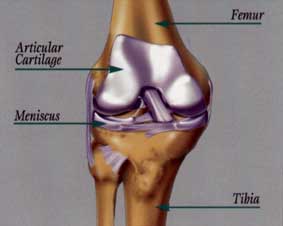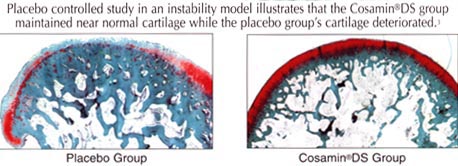HOME
Medical Topics:
Ligament
Injury
Disease
About The Doctor:
Questions?
Email at:
GNYaco@aol.com
| DEGENERATIVE
JOINT DISEASE |
 |
1. Definition: Degenerative joint disease (D.J.D.) or
Osteoarthritis is a degeneration of the joint surface resulting
from wear and tear over many years. This process usually
manifests itself after age fifty, however it may begin sooner
if there is a history of injury to the joint. The cartilage
surfaces, known as articular or hyaline cartilage,
deteriorate by softening fissuring, fragmenting and finally
dissolving away. The underlying exposed bone is then
subjected to greatly increased stress resulting in pain,
swelling and gradual loss of joint function.
2. Treatment: Traditional drug therapy
for D.J.D. of the knee has
focused
on the use of oral nonsteroidal anti-inflammatory
medications...Naprosyn,
Feldene and Motrin to name a few.
These agents
have a significant incidence of stomach
irritation
and even ulceration and are only capable of
treating
the symptoms...not the disease. Cortisone and its
synthetic
derivatives have been used by direct injection into
the knee
joint for decades with good relief of symptoms but,
again,
allow the disease to progress unabated.
In the last
decade, research in the field of D.J.D. has begun
to focus
on restoring the damaged articular cartilage. Several
of these
"cartilage supplements" are now available in oral
and indictable
form.
![]()

Glucosamine
and Chondroitin Sulfate (Cosamin DS) are
chemicals
found in human articular cartilage. Recently, these
compounds
have been made available for the treatment
of
D.J.D.
When taken in the proper oral combination,
these
"neutraceuticals"
can decrease pain and improve joint
function
in cases of mild to moderate osteoarthritis.
Glucosamine
is a building block used in hyaline cartilage
synthesis,
while Chondroitin Sulfate inhibits cartilage
breakdown.
Taken together, these chemicals are far more
effective
than either one taken alone. Most commercially
available
brands contain 500 mg. of Glucosamine
and 400
mg. of
Chondroitin Sulfate in oral form. Dosing varies
with
the patient's
weight, symptoms and duration of treatment. 4
to 8 weeks
of treatment is usually necessary before relief of
symptoms
is noticed. There have been NO significant side
effects
reported to date. These products are available without
a prescription
and can be obtained at most pharmacies and
health
food stores. Patients should consult there
physician
before
and during treatment.
-----------
Hyaluronic
Acid is a chemical that is found in human
synovial
fluid and hyaline cartilage. Recently, this compound
has been
made available in injectible form for the treatment
of mild
to moderate osteoarthritis of the knee. It
is derived
from rooster
combs and processed into a liquid that is quite
viscous.
This is injected directly into the knee joint and is
believed
to work by increasing the viscosity of the
synovial
fluid in
the knee as well as by promoting cartilage synthesis.
The injections
are given once every week for three to five
weeks after
which patients will begin
to experience relief of
symptoms.
Pain relief and improvement of joint function can
last up
to one year after treatment is completed. Side effects
include
local pain and swelling at the injection site.
This
medication
is only available by prescription and should
only
be administered
by a physician experienced in giving
intra-articular
injections.
Back to the Top